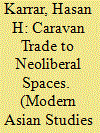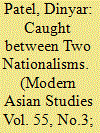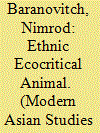|
|
|
Sort Order |
|
|
|
Items / Page
|
|
|
|
|
|
|
| Srl | Item |
| 1 |
ID:
179914


|
|
|
|
|
| Summary/Abstract |
Based on a detailed case study of the socialist transformation of the Shanghai Great World Amusement Centre (Dashijie), this article documents state-building efforts during the early years of the People's Republic of China (PRC). Between 1950 and 1958, the Communist regime incrementally transformed the power configuration within Dashijie, promoting dramatic changes in its personnel, institutional structures, drama performances, and physical space. Over the course of this process, Dashijie seemed to become a ‘loftier’ cultural organization in accordance with the aims of its transformation. This transfigured Dashijie, however, fell out of favour with the people of Shanghai. This multifaceted transformation process reflects considerable state capacities on the one hand and illustrates the complexity of state capacities—their unevenness and the limitations of a strong state—on the other. The complexity of state capacities thus shaped and was embedded in the process and outcome of this socialist cultural transformation. Since the Chinese state is once again making strenuous efforts at culture-building, an overview of cultural transformation in the early PRC era has important contemporary implications.
|
|
|
|
|
|
|
|
|
|
|
|
|
|
|
|
| 2 |
ID:
179911


|
|
|
|
|
| Summary/Abstract |
Located along Pakistan's central Asian margins, the high mountain region of Gilgit-Baltistan borders Afghanistan and India, and since 1969 has connected Pakistan to China. In this article, I argue that over the last 50 years, expanding forms of connectivity between Pakistan and China were localized in Gilgit-Baltistan through three processes: (1) from 1969, overland connectivity between Gilgit-Baltistan and western China has enabled Pakistan to imagine and project expansive ties—and geopolitical aspirations—that transcend the border areas where the cross-border trade was initially localized; (2) unfolding ties between the two countries were accompanied by new material exchanges: initially barter trade and regulated caravans, followed by private commerce in the mid-1980s and, finally, economic corridor development under the Belt and Road Initiative; and (3) Chinese investments in Pakistan were part of a new cycle of global accumulation. Concurrently, in the wake of transnational investments, local governance in Gilgit-Baltistan adopted neoliberal administrative measures: the prioritizing of investment capitalism, the privatization of public goods and services, and securitization.
|
|
|
|
|
|
|
|
|
|
|
|
|
|
|
|
| 3 |
ID:
179908


|
|
|
|
|
| Summary/Abstract |
In 1922, a group of wealthy Parsis in Bombay founded an organization that they dubbed the Iran League. Originally designed to assist their fellow Zoroastrians in Iran, who had suffered from centuries of oppression, the League quickly expanded its objectives to include the promotion of broader Indo-Iranian cultural and economic relations. It became a major player in the flow of ideas, literature, business, and tourist traffic between the two countries. Parsi fervour for Iran stemmed from the brand of Iranian nationalism promoted by Reza Shah, which celebrated the country's Zoroastrian past. In response, the League's leaders argued that the Parsis of India could play a special role in the ‘regeneration’ of Iran under the shah's supposedly benign rule. By the 1930s, however, Parsis’ embrace of Iranian nationalism became a clear reflection of their deep concerns about Indian nationalist politics: they cast Iran as an idealized alternative to contemporary India, where the Indian National Congress had supposedly taken an ominously ‘anti-Parsi’ turn. The Iran League, therefore, was caught between two nationalisms. Worry about India's future even prompted some Parsis to argue that their community should ‘return’ to their ancestral homeland of Iran. The story of the Iran League thus demonstrates the complex position of minorities vis-à-vis the brands of nationalism in development during the interwar years. The Parsis, a wealthy but microscopic minority, responded to political anxieties at home by romanticizing a foreign country and taking part in a wholly foreign nationalist project.
|
|
|
|
|
|
|
|
|
|
|
|
|
|
|
|
| 4 |
ID:
179910


|
|
|
|
|
| Summary/Abstract |
Encyclopedias are purportedly all-encompassing, authoritative presentations of information compiled mainly by experts for an audience of non-specialists. Believed to offer only universal ‘facts’, they have long been associated with objectivity. Yet, by arranging information into a usable form, encyclopedias inevitably convey particular ideologies and ideals. As a result, they offer a lens into the changing ‘truths’ upheld by or expected of readers. This article compares three successive, high-profile Japanese encyclopedias, each bearing the title Sekai bunkashi taikei [Encyclopedia of world cultural history]. Somewhat differently from today, the field of world cultural history purported to ‘objectively’ cover the widest relevant space (earth) and time (the human past). However, the specific concerns and commitments of world cultural historians changed greatly between the 1920s, when the first encyclopedia was published, and the 1960s, when the final volumes of the third series appeared. By looking closely at both the production and consumption of these texts, this article shows the deeply politicized ways in which ‘objective’ knowledge of the world was interpreted, implemented, marketed, and received by the Japanese public during the years of nation-building, imperial expansionism, and the Cold War.
|
|
|
|
|
|
|
|
|
|
|
|
|
|
|
|
| 5 |
ID:
179915


|
|
|
|
|
| Summary/Abstract |
Drawing on ideas from ecocriticism, literary animal studies, and post-colonial studies, as well as anthropology and cultural studies, this article examines the representations of animals in contemporary Sino-Mongolian literature and art, and the various connections between these representations and issues related to ethnic and environmental politics. I propose that the intensive engagement of Chinese-Mongolian writers and artists with animals is related first and foremost to the central role that animals, both wild and domesticated, have traditionally played in Mongolian nomadic pastoralist culture. However, I also argue that it is closely connected to two interrelated processes that are currently taking place in Inner Mongolia: the severe degradation of the Inner Mongolian grassland and the rapid sinicization of China's Mongols. I suggest that in the context of this environmental and cultural crisis, the engagement with animals reflects anxiety about the fate of the Inner Mongolian grassland, the fate of real animals, which, for centuries, have been closely associated with this landscape and Mongolian nomadic culture, and, most importantly, the fate of Mongolian culture itself. I also argue that Sino-Mongolian writers and artists use literary and artistic animals to construct and assert Mongolianness as part of their search for an ‘authentic’ ethnic identity, and to comment critically on the impact that Chinese domination has had on the Inner Mongolian grassland, its indigenous human and non-human inhabitants, and Mongolian culture and identity. Finally, I propose that through their ethnic environmentalism, Chinese-Mongolian artists and writers have made an important contribution to the development of China's environmental movement.
|
|
|
|
|
|
|
|
|
|
|
|
|
|
|
|
| 6 |
ID:
179907


|
|
|
|
|
| Summary/Abstract |
This article examines the relationship between language shift and identity among diaspora Sindhis in India and Southeast Asia. It focuses on questions concerning how members of this community reproduce identity through language shift. The first part of the article describes identity and language shift among diaspora Sindhis in post-partition India. It argues that language shift facilitates the reproduction of core cultural modalities among diaspora Sindhis. The second part describes the history of diaspora Sindhis in Southeast Asia and analyses language shift. It contends that language shift enables diaspora Sindhis to suspend a connection between mother-tongue proficiency and identity. The article concludes by discussing how the diaspora Sindhi experience retunes the interval that conventionally connects language shift to cultural change.
|
|
|
|
|
|
|
|
|
|
|
|
|
|
|
|
| 7 |
ID:
179912


|
|
|
|
|
| Summary/Abstract |
On 14 April 1923, in the dead of night, an English girl was kidnapped from her bedroom in a military bungalow in the Kohat Cantonment on India's North-West Frontier. The kidnapping is a notorious incident that has been told and retold in multiple languages, disciplines, and media for almost a century. From the colonial perspective, the kidnapping was seen as an ‘outrage’ that demonstrated the lawless savagery of the tribes who inhabited this strategically significant Indo-Afghan borderland. From the local perspective, the kidnappers led by Ajab Khan Afridi were valiant heroes who boldly challenged an alien and oppressive regime. This article adopts a gendered lens of historical analysis to argue that the case offers important conceptual insights about the colonial preoccupation with frontier security. In the British empire, the idea of the frontier signified a racial line dividing civilization from savagery. The colonial frontier was also a zone of hyper-masculinity where challenges to state power were met with brutal violence in a muscular performance of masculine authority. In this space where ‘no signs of weakness’ could be shown, the abduction of Molly Ellis represented an assault on the fictive image of white, male invincibility and the race–gender hierarchy that defined the colonial system.
|
|
|
|
|
|
|
|
|
|
|
|
|
|
|
|
| 8 |
ID:
179913


|
|
|
|
|
| Summary/Abstract |
The cultural and historical dimensions of rural lives matter. However, development practitioners and writings tend to play down these aspects. This article demonstrates the significance of oral history in revealing the meanings of women smallholders’ millet-based foodways in southern India. It argues that women farmers’ cultural practices around food constitute fundamental ‘capabilities’ nurtured over a long historical duration, and are essential to any meaningful articulation of ‘development’. Drawing on age-old spiritual beliefs and practices involving non-human entities, the women demonstrate fine-tuned skills in nurturing seeds and growing crops, in preparing and cooking food, and in discerning food tastes, particularly in relation to the local staple ragi, or finger millet. They also express their creativity in the joys of performing songs and farming rituals linked to the agricultural cycle. In this way, cultural capabilities express significant dimensions of women's agency exercised in the intimately related spheres of food and farming. Oral history thus emerges as a research method capable of generating insights into concrete manifestations of culture over a significant historical duration, one that is particularly conducive to reclaiming the voices and life experiences of subaltern groups such as women smallholders who are either not heard or are marginalized in written contemporary and historical documentary records.
|
|
|
|
|
|
|
|
|
|
|
|
|
|
|
|
| 9 |
ID:
179909


|
|
|
|
|
| Summary/Abstract |
This article analyses Bell Hill (Kane no naru oka), the NHK radio drama designed by US-occupation personnel, and the fervent audience response, while treating this redemption story of war-affected homeless children as a trope for Japanese reorientation under American tutelage. Specifically, it examines the two major tenets of the rehabilitative vision delineated in the serial, liberal guidance based on the principles of self-government and sentimental brotherhood. Questioning the underlying assumption of post-war discourses that they were new, humanitarian fundamentals for Japan's democratic transformation, this study considers liberal principles and sentimentalism as technologies of power and the self that affected both drama's characters and receptive audiences to refigure themselves as responsible and empathetic members of the newly imagined national community. Through this approach, the article suggests a way to resist a simplistic account of Japan's post-war reorientation as either unilateral indoctrination or liberation. The historical experience is instead rearticulated as a process of self-rehabilitation within the biopolitical order of American Cold-War governmentality. This rearticulation opens a further possibility to locate the specific rendering of Japan's post-war rehabilitation within a wider trans-war continuum of human reformation projects implemented through similar technologies of power and the self in Japan and beyond.
|
|
|
|
|
|
|
|
|
|
|
|
|
|
|
|
| 10 |
ID:
179906


|
|
|
|
|
| Summary/Abstract |
In the 1910s and 1920s, when Indonesian communists first seriously engaged with Marxism, they faced the questions of how to translate Marx's concepts from Dutch, the language in which they generally encountered them, into Malay, the lingua franca of the Indonesian archipelago, and how to make these ideas relevant in an Asian and largely Islamic context. Focusing on three aspects of Marxism—the ‘scientific’ nature of communism, class conflict in feudal and capitalist society, and the relationship between communism and Islam—I argue that Indonesian communists alternated between transliteration and translation in their exposition of Marxism. Transliterating ‘universal’ Marxist categories such as proletarian (proletar) and capitalism (kapitalisme) allowed Indonesian communists to speak in global terms and strengthened their claim that Marxism was a science with a universal terminology. At the same time, there was a process of ‘localization’, whereby foreign Marxist materials were translated to bring them closer to local cultural norms. Malay substitutes were found for Marx's typology of classes and historical eras, while Arabic terms associated with Islam were used to add a moral dimension to the Marxist critique of capitalism. These translations grounded Marxism in Islam and Indonesian history, but also elevated vernacular terms to universal status by eliding them with Marx's categories. The resulting style of Indonesian Marxism was multilingual. From the 1930s, however, Indonesian nationalists consciously moved away from transliteration, devising a more thoroughly Indonesian political vocabulary to replace Marx's terms, though one still clearly influenced by Marxism.
|
|
|
|
|
|
|
|
|
|
|
|
|
|
|
|
|
|
|
|
|